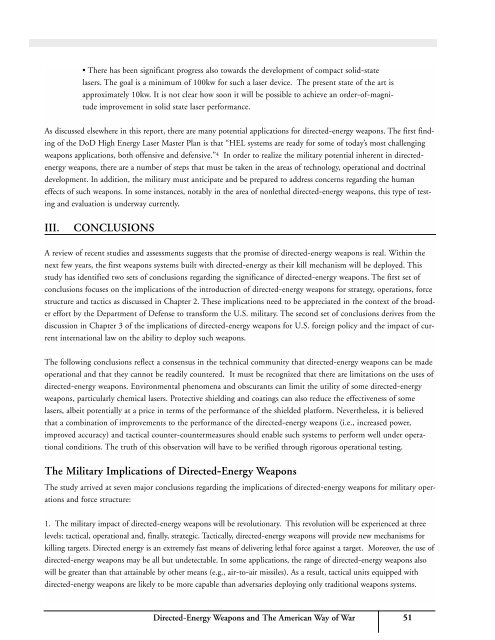directed-energy-weapons
directed-energy-weapons
directed-energy-weapons
You also want an ePaper? Increase the reach of your titles
YUMPU automatically turns print PDFs into web optimized ePapers that Google loves.
• There has been significant progress also towards the development of compact solid-statelasers. The goal is a minimum of 100kw for such a laser device. The present state of the art isapproximately 10kw. It is not clear how soon it will be possible to achieve an order-of-magnitudeimprovement in solid state laser performance.As discussed elsewhere in this report, there are many potential applications for <strong>directed</strong>-<strong>energy</strong> <strong>weapons</strong>. The first findingof the DoD High Energy Laser Master Plan is that “HEL systems are ready for some of today’s most challenging<strong>weapons</strong> applications, both offensive and defensive.” 4 In order to realize the military potential inherent in <strong>directed</strong><strong>energy</strong><strong>weapons</strong>, there are a number of steps that must be taken in the areas of technology, operational and doctrinaldevelopment. In addition, the military must anticipate and be prepared to address concerns regarding the humaneffects of such <strong>weapons</strong>. In some instances, notably in the area of nonlethal <strong>directed</strong>-<strong>energy</strong> <strong>weapons</strong>, this type of testingand evaluation is underway currently.III.CONCLUSIONSA review of recent studies and assessments suggests that the promise of <strong>directed</strong>-<strong>energy</strong> <strong>weapons</strong> is real. Within thenext few years, the first <strong>weapons</strong> systems built with <strong>directed</strong>-<strong>energy</strong> as their kill mechanism will be deployed. Thisstudy has identified two sets of conclusions regarding the significance of <strong>directed</strong>-<strong>energy</strong> <strong>weapons</strong>. The first set ofconclusions focuses on the implications of the introduction of <strong>directed</strong>-<strong>energy</strong> <strong>weapons</strong> for strategy, operations, forcestructure and tactics as discussed in Chapter 2. These implications need to be appreciated in the context of the broadereffort by the Department of Defense to transform the U.S. military. The second set of conclusions derives from thediscussion in Chapter 3 of the implications of <strong>directed</strong>-<strong>energy</strong> <strong>weapons</strong> for U.S. foreign policy and the impact of currentinternational law on the ability to deploy such <strong>weapons</strong>.The following conclusions reflect a consensus in the technical community that <strong>directed</strong>-<strong>energy</strong> <strong>weapons</strong> can be madeoperational and that they cannot be readily countered. It must be recognized that there are limitations on the uses of<strong>directed</strong>-<strong>energy</strong> <strong>weapons</strong>. Environmental phenomena and obscurants can limit the utility of some <strong>directed</strong>-<strong>energy</strong><strong>weapons</strong>, particularly chemical lasers. Protective shielding and coatings can also reduce the effectiveness of somelasers, albeit potentially at a price in terms of the performance of the shielded platform. Nevertheless, it is believedthat a combination of improvements to the performance of the <strong>directed</strong>-<strong>energy</strong> <strong>weapons</strong> (i.e., increased power,improved accuracy) and tactical counter-countermeasures should enable such systems to perform well under operationalconditions. The truth of this observation will have to be verified through rigorous operational testing.The Military Implications of Directed-Energy WeaponsThe study arrived at seven major conclusions regarding the implications of <strong>directed</strong>-<strong>energy</strong> <strong>weapons</strong> for military operationsand force structure:1. The military impact of <strong>directed</strong>-<strong>energy</strong> <strong>weapons</strong> will be revolutionary. This revolution will be experienced at threelevels: tactical, operational and, finally, strategic. Tactically, <strong>directed</strong>-<strong>energy</strong> <strong>weapons</strong> will provide new mechanisms forkilling targets. Directed <strong>energy</strong> is an extremely fast means of delivering lethal force against a target. Moreover, the use of<strong>directed</strong>-<strong>energy</strong> <strong>weapons</strong> may be all but undetectable. In some applications, the range of <strong>directed</strong>-<strong>energy</strong> <strong>weapons</strong> alsowill be greater than that attainable by other means (e.g., air-to-air missiles). As a result, tactical units equipped with<strong>directed</strong>-<strong>energy</strong> <strong>weapons</strong> are likely to be more capable than adversaries deploying only traditional <strong>weapons</strong> systems.Directed-Energy Weapons and The American Way of War51


